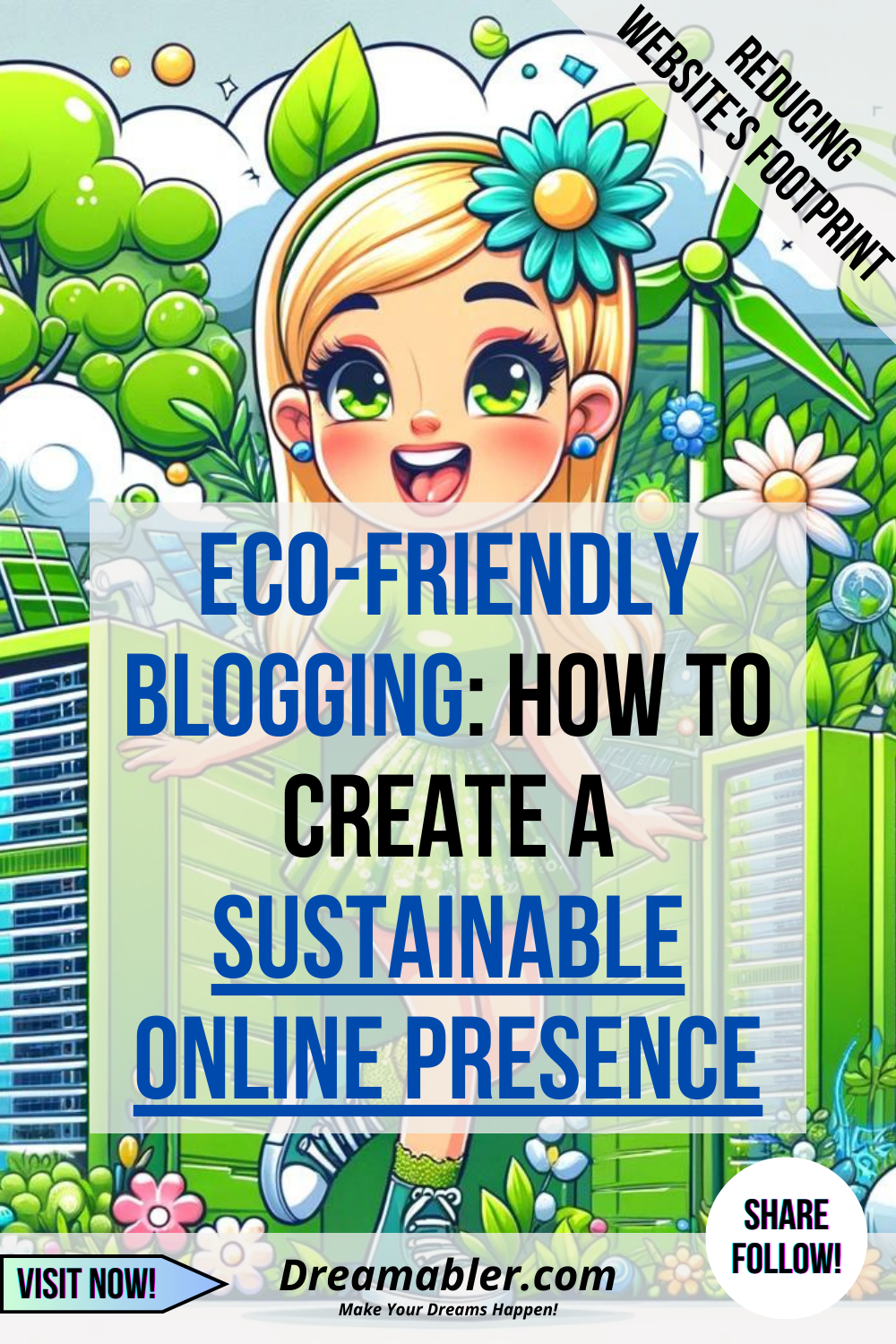Last Updated on March 13, 2024 by Mika
Ever stopped to think if the internet could leave a carbon footprint? Sounds strange, right? But it’s true. Every time we hop online, browse websites, or post content, we contribute to digital pollution. So, what’s the deal with making our blogging practices more sustainable?
Why go green with your blog, you might wonder? Well, it’s all about doing our bit for the planet, even in the virtual world. The internet’s energy consumption is soaring, making it crucial for us to consider the environmental impact of our online activities, including blogging.
Got questions about how to start? Wondering if it’s complicated or if it will cramp your style? Rest easy. The answers are simpler than you might think, and the journey to eco-friendly blogging might just add a fresh layer of authenticity and appeal to your blog.
Let’s dive into how you can reduce your digital footprint while still rocking the blogging world. Ready to make a difference? Let’s roll!
The Carbon Footprint of the Internet
According to Yoast, an average web page emits about 0.5 grams of CO2 per view, meaning a site with 10,000 monthly views could generate 60 kg of CO2 annually. RESET.org adds that the ICT sector accounts for roughly 4% of global emissions, twice that of aviation, with an average site producing 553 kg of CO2 yearly from 10,000 monthly views.
The hidden environmental cost of online content
You see, the internet relies on a vast network of data centers, which are basically massive warehouses filled with servers storing all the data we create and consume. These data centers are energy-hungry giants that need to be powered up 24/7, and cooling them down is no small feat either.
So, every click, every swipe – it’s all powered by electricity, much of which still comes from fossil fuels. It’s kind of like driving a car in the digital highway.
How your blog contributes to digital pollution
Now, let’s talk about our blogs. Each blog might seem like a small fish in the big internet ocean, but when you think about the millions of blogs out there, it all adds up. High-resolution images, videos, and inefficient coding can make your blog a gas-guzzler of the digital world.
It’s like packing your blog with a V8 engine when maybe a more eco-friendly option could do the job.
But here’s the kicker – it’s not all doom and gloom. There are ways to make your blog leaner, greener, and just as mean when it comes to captivating your audience. It’s about making smart choices that reduce the energy your blog needs, without putting a damper on your creative spirit.
So, are we ready to take a closer look at our digital habits and make some eco-friendly tweaks? It’s about giving our blogs a green makeover, turning them into models of digital sustainability.
Let’s pave the way for a greener, cleaner internet, one blog post at a time. Ready to roll up your sleeves and get started?
Choosing a Green Web Host

Picking where your blog lives is a big deal, right? It’s like choosing a home for your digital baby. But here’s a twist – what if your blog’s home could be eco-friendly too? That’s where green web hosting comes into play. It’s about giving your blog a comfy, sustainable spot on the internet.
What makes a web host eco-friendly?
You might wonder, “What’s the green magic behind eco-friendly web hosting?” Well, it boils down to using renewable energy sources like wind or solar power to run those energy-thirsty data centers.
Some hosts take it a step further by investing in energy efficiency and even buying carbon offsets to balance out their environmental impact. It’s like they’re planting digital trees for every bit of energy they use!
Top green hosting providers for your blog
Now, you’re probably itching to know who’s who in the green hosting world. There are some standout players who’ve made eco-friendliness their badge of honor. They’re not just talking the talk; they’re walking the walk by powering their servers with 100% renewable energy and implementing energy-saving practices.
Choosing one of these hosts is like voting for the environment with your blog. It’s a small choice that can make a big difference.
Kinsta is not only one of the best WordPress hosts, but it’s also green hosting as they use Google Cloud Platform and Cloudflare infrastructure, which means Kinsta hosted websites run on 100% renewable energy.
- Super fast WP hosting
- Automatic backups
By purchasing products and services through affiliate links, you can support our work at no additional cost to you. In many cases, you’ll even receive extra benefits, such as discounts. Your support is greatly appreciated.
some bonus text here some bonus text here
By purchasing products and services through affiliate links, you can support our work at no additional cost to you. In many cases, you’ll even receive extra benefits, such as discounts. Your support is greatly appreciated.
So, how about we make our blogs not just spaces for inspiring words and beautiful images but also pioneers in the digital sustainability movement? By hosting our blogs with companies that care about the planet, we’re taking a stand. We’re saying, “Hey, it matters where my blog lives.”
Switching to a green web host might seem like a small step, but it’s part of a bigger journey towards a more sustainable internet. And guess what? Your readers will notice and appreciate your commitment to doing good for the planet. It’s a win-win – for your blog, your audience, and the Earth.
Optimizing Website Efficiency
Making your blog not just look good but also run efficiently is like tuning a car for better mileage. It’s all about getting more zoom with less vroom, or in our case, less energy. So, how do we make our blogs sleek, fast, and green? It’s simpler than you might think.
Streamlining your site for speed and sustainability
First up, think of your blog as a streamlined vehicle. The heavier it is, the more energy it needs to move. Large images, complex scripts, and bulky design elements can slow down your site and consume more energy.
By optimizing images, minifying code, and choosing a clean, efficient design, you’re essentially shedding unnecessary digital weight. It’s like choosing a bike over a truck for your morning commute – it gets the job done with far less energy.
Practical tips for reducing your website’s energy consumption
Here’s where the rubber meets the road. Let’s talk actionable tips:
- Compress those images: High-quality images are great, but they can be heavy. Use tools to compress them without losing quality.
- Simplify your design: A clean, minimalist design isn’t just trendy; it’s also eco-friendly.
- Cache it up: Use caching to save energy by storing parts of your site locally on visitors’ devices, reducing the load on your server.
- Go for green plugins: If you’re using a platform like WordPress, look for plugins designed to improve efficiency and reduce energy consumption.
By taking these steps, you’re not just making your blog faster and more user-friendly; you’re also making it greener.
It’s about being mindful of the resources our blogs use and finding smart ways to minimize that footprint. Plus, let’s be honest, who doesn’t love a website that loads in the blink of an eye?
Optimizing your blog for efficiency is a win all around. Your readers get a smoother experience, you get a blog that stands out for its performance and its commitment to sustainability, and the planet gets a little less digital strain. It’s a small effort with big ripple effects.
Creating Content with a Conscience
When we talk about eco-friendly blogging, it’s not just about the how, but also the what. The content you create and share carries weight, shaping thoughts, sparking conversations, and even inspiring action.So, why not use that power for good? Let’s dive into creating content that’s not just engaging but also mindful of our planet.
Writing about sustainability: Why it matters
You see, every post you publish is an opportunity to spread awareness, to make people think, and to encourage change.
Whether you’re sharing tips on living more sustainably, spotlighting eco-friendly products, or discussing environmental issues, you’re contributing to a larger conversation. It’s like planting seeds in a garden; with time and care, they can grow into something beautiful and impactful.
Engaging your audience in green initiatives
But it’s not just about what you say; it’s also about how you involve your audience. Interactive content like challenges, quizzes, and surveys can engage your readers in fun and meaningful ways.
Imagine hosting a “Green Week” challenge on your blog, encouraging readers to try one eco-friendly action each day. It’s a way to turn your blog into a community hub for positive change.
Creating content with a conscience is about blending your passion for blogging with a purpose that goes beyond just clicks and views. It’s about using your voice to advocate for a healthier planet, to inspire your readers to think differently, and to take action in their own lives.
So, let’s make every word count, every post a step towards a more sustainable future. It’s not just about building an audience; it’s about building a movement, one blog post at a time. And who knows? The ripple effect of your words might just reach further than you ever imagined.
Promoting Your Blog the Eco-Friendly Way
Now, let’s chat about getting the word out about your awesome, green-minded blog. Promotion is key to growing your audience, but how do we do this in an eco-friendly way? It’s like hosting a party but making sure the invites and decorations don’t end up harming the planet.
Eco-conscious marketing strategies
First off, digital marketing is your best friend here. It’s like sending out electronic invites instead of paper ones. Utilize email newsletters, SEO strategies, and online collaborations to spread the word without spreading waste.
But here’s a pro tip: be mindful of your email list. Sending out tons of emails to uninterested parties is like leaving the tap running—wasteful. Keep your list clean and engaged.
Leveraging social media for sustainable promotion
Social media is a powerhouse for promotion, but let’s use it wisely. Share your content, engage with your community, but also highlight your eco-friendly ethos. It’s like wearing a badge that says, “I care about the planet, and my blog does too.”
And don’t forget about the power of shareable, eco-themed content. Infographics, quick tips, and thought-provoking questions can go viral, spreading your green message far and wide.
Promoting your blog in an eco-conscious way isn’t just about reaching more eyes; it’s about reaching the right eyes—people who care about the planet as much as you do. It’s about building a community that’s not just interested in your content but also in the values it represents.
So, let’s get creative and considerate with our promotion. Let’s make sure that as we grow our blogs, we’re also nurturing our planet. After all, what’s the point of having a wide reach if we’re not reaching out with care and responsibility?
The Ripple Effect of Eco-Friendly Blogging
We’ve traveled through the ins and outs of making our blogs more sustainable, from the servers that host our sites to the content we create and how we share it with the world. It’s like we’ve been on a green journey, tweaking and tuning our digital practices to tread more lightly on this planet.
But here’s the thing: it’s not just about the changes we make to our blogs. It’s about the bigger picture, the ripple effect these changes can create. Each eco-friendly choice sends out ripples, influencing others, from our readers to fellow bloggers, and even beyond the digital realm.
Whether it’s choosing a green web host, optimizing our site’s efficiency, crafting content that inspires, or promoting our blogs in eco-conscious ways, every action counts.
If you’ve enjoyed diving into the world of eco-friendly blogging with me, don’t forget to hit that subscribe button and follow my journey on social media! Your support means the world.
And I’d love to hear your thoughts and ideas on sustainable blogging—drop your comments below and let’s keep the green conversation going!
FAQ
⭐️ Are there specific themes or templates that are more eco-friendly for websites?
Yes, eco-friendly themes or templates typically prioritize speed and efficiency. They use minimalistic designs, optimized images, and clean code to reduce the amount of data transferred and processed, which can lower the website’s energy consumption.
⭐️ Can the choice of fonts affect a website’s carbon footprint?
Interestingly, yes. Some fonts require more data to render than others. Using simpler, web-optimized fonts can reduce the amount of data your website needs to load, contributing to a smaller carbon footprint.
⭐️ How significant is the impact of social media on digital carbon emissions?
Social media platforms, with their massive data centers and high user engagement levels involving data-intensive content (like videos and images), contribute significantly to digital carbon emissions. However, they’re also working on sustainability initiatives to reduce their impact.
⭐️ What role do content delivery networks (CDNs) play in reducing a website’s carbon footprint?
CDNs can reduce a website’s carbon footprint by caching content closer to the end-user, decreasing the distance data needs to travel. This efficiency not only speeds up content delivery but also reduces energy consumption.
⭐️ How can individual bloggers or small website owners measure their site’s carbon footprint?
There are online tools and calculators available that can estimate a website’s carbon footprint based on factors like page size, traffic, and hosting details. These tools often provide tips for reducing emissions as well.
⭐️ What’s the impact of email marketing on a website’s carbon footprint, and how can it be minimized?
Email marketing contributes to digital carbon emissions through the energy used in data centers for sending, receiving, and storing emails. Minimizing impact involves cleaning email lists regularly to avoid sending unnecessary emails and optimizing email content for size.
⭐️ Is it more sustainable to use external platforms for video hosting instead of embedding them directly on a website?
Yes, using external video hosting platforms like YouTube or Vimeo can be more sustainable as it leverages their optimized delivery networks and reduces the load on your website’s server, thereby potentially lowering the carbon footprint.






